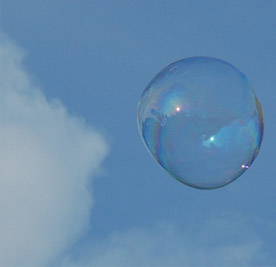The history of lightbulbs is only two hundred years old starting with Humphry Davy an English chemist in 1809. That said there have been very similar consisting: a filament, a gas or under vacuum and a glass bulb. So they all share one important trait: they're all solid. A new design has changed this a little using surface tension of a bubble. So it can pop and reform making a hazy bubble light.
The Surface Tension Lamp, is a design by Italian designers Spazio Rossana Orlandi from Netherland's company Front and Boo. It replaces the lightbulb's glass with liquid water. In the middle an LED lamp shines through a bubble as it expands. The light is reflected to create luminescence. Then POP! The surface tension bulb pops. However when this bubble pops a new on takes its place. Three million bubbles will expand and explod over the LED lamp's lifespan of 50000 hours.
Check them out in the video below:
Possibly this is not the most practical idea since it does not give out so much light. Maybe a it will give a hazy glow. It might be good for certain applications like outside because the liquid might spray out in a mist when the bubbles pop. It would be interesting also to see whether the surface tension can be altered to make the bulb last longer.

 The
The 


